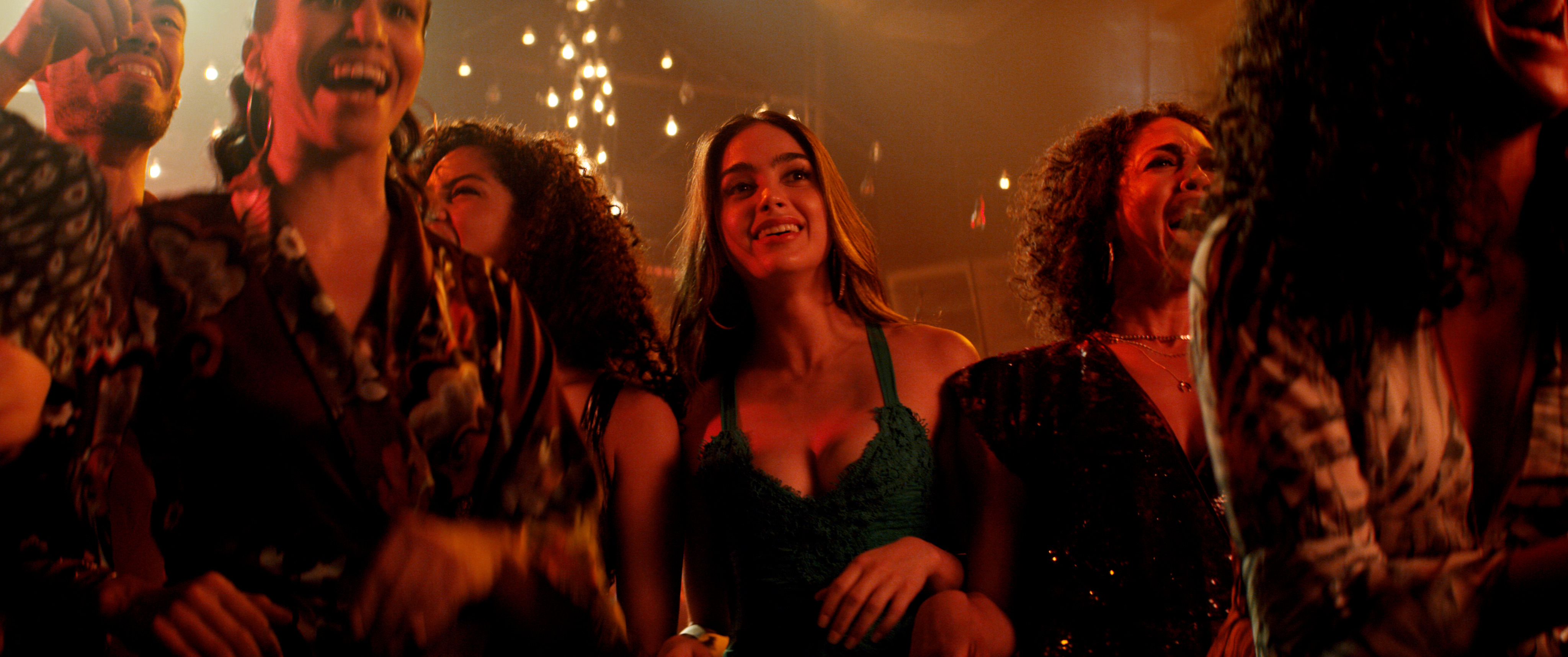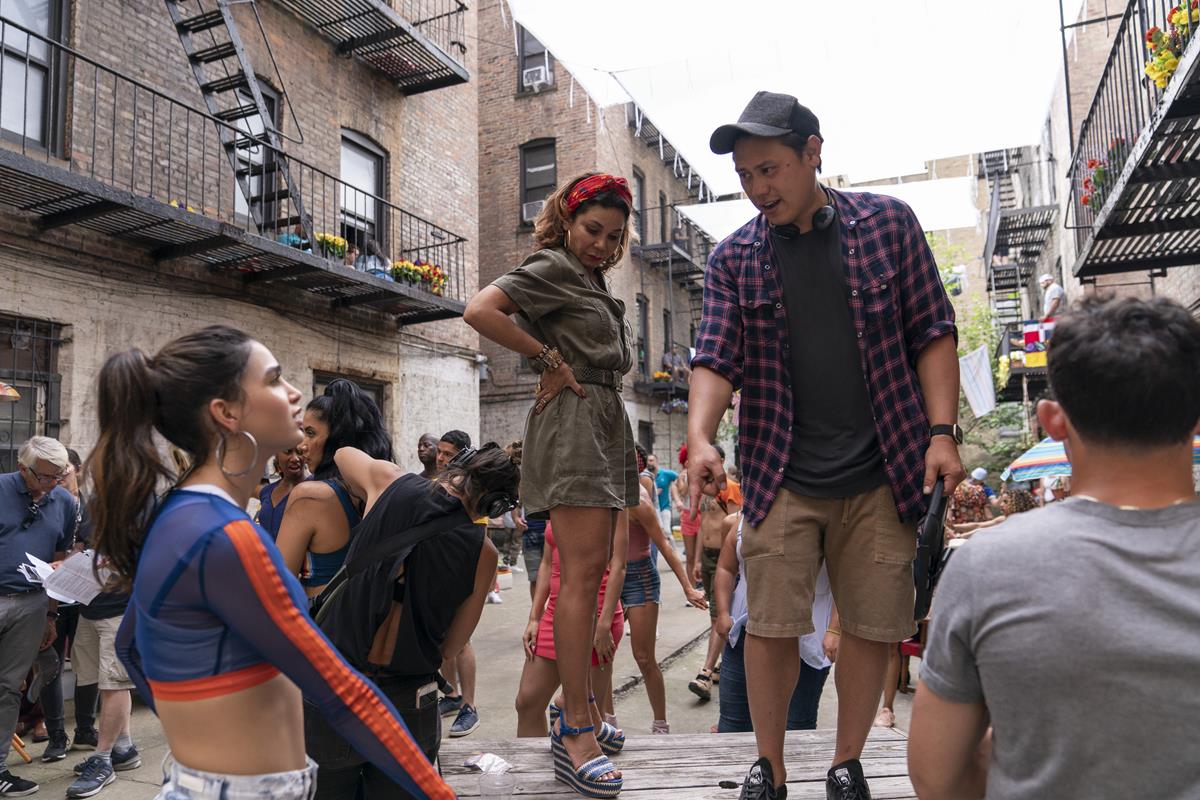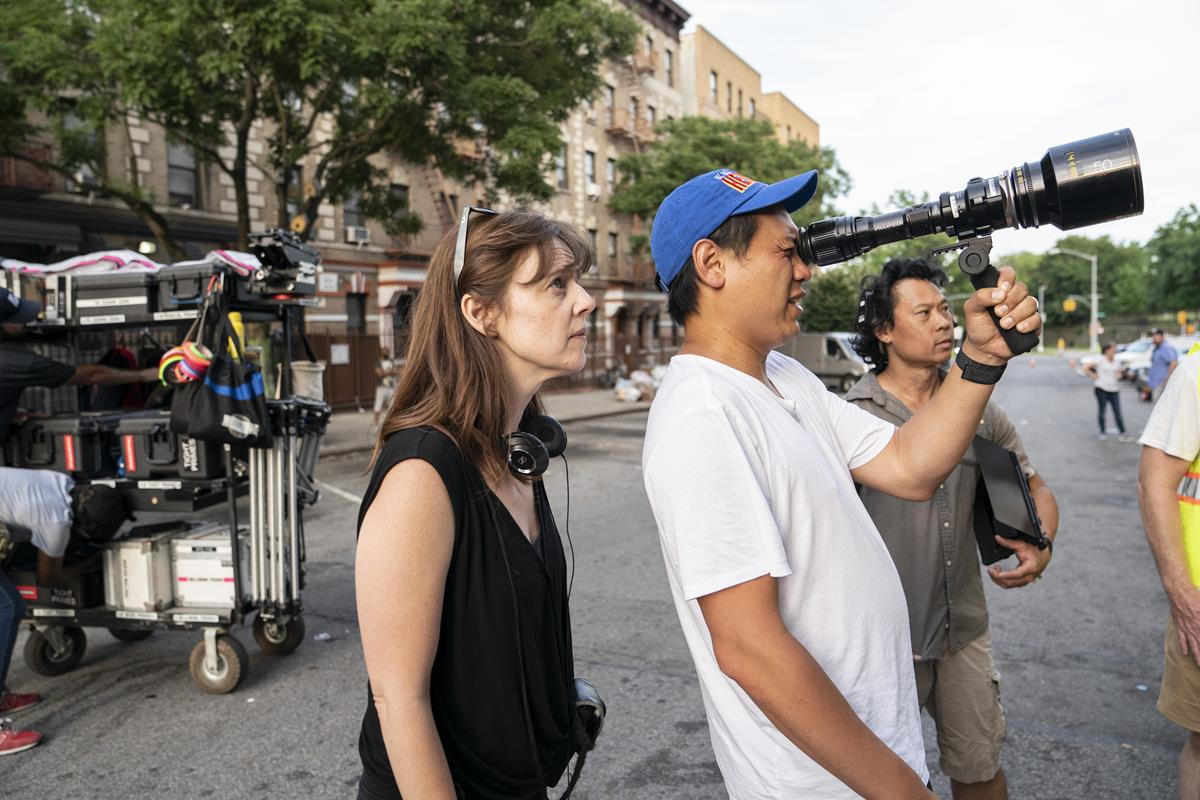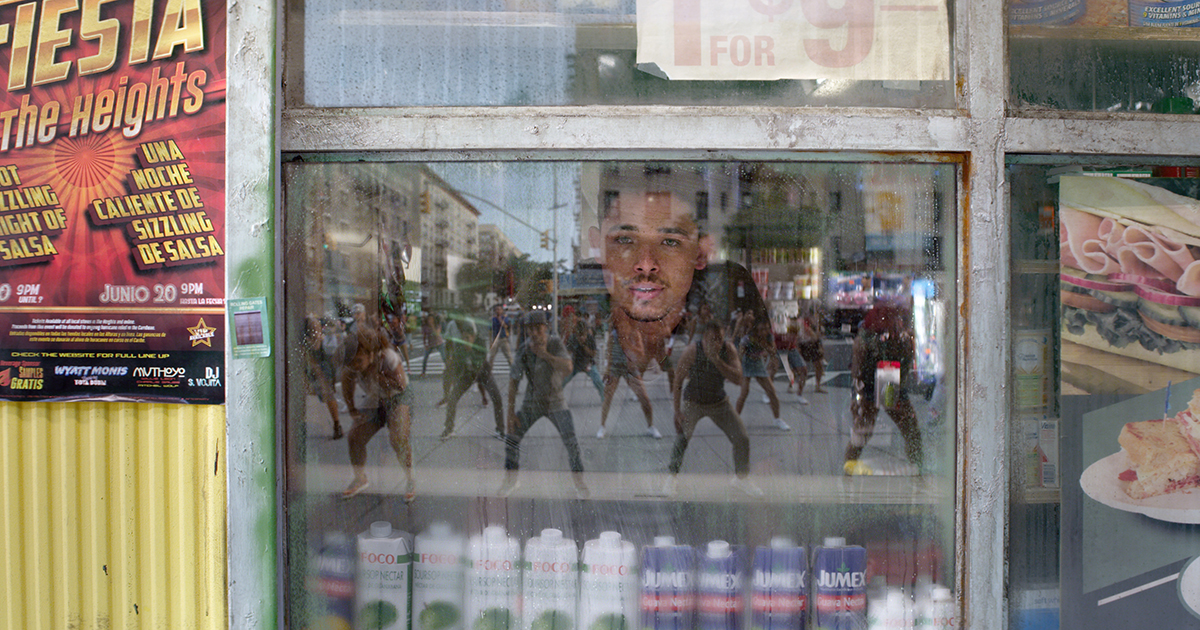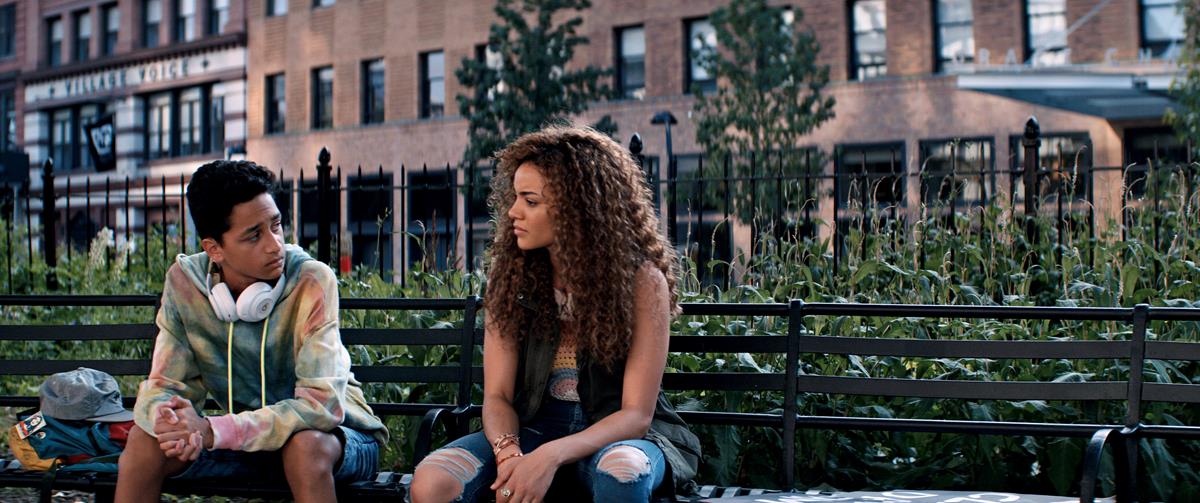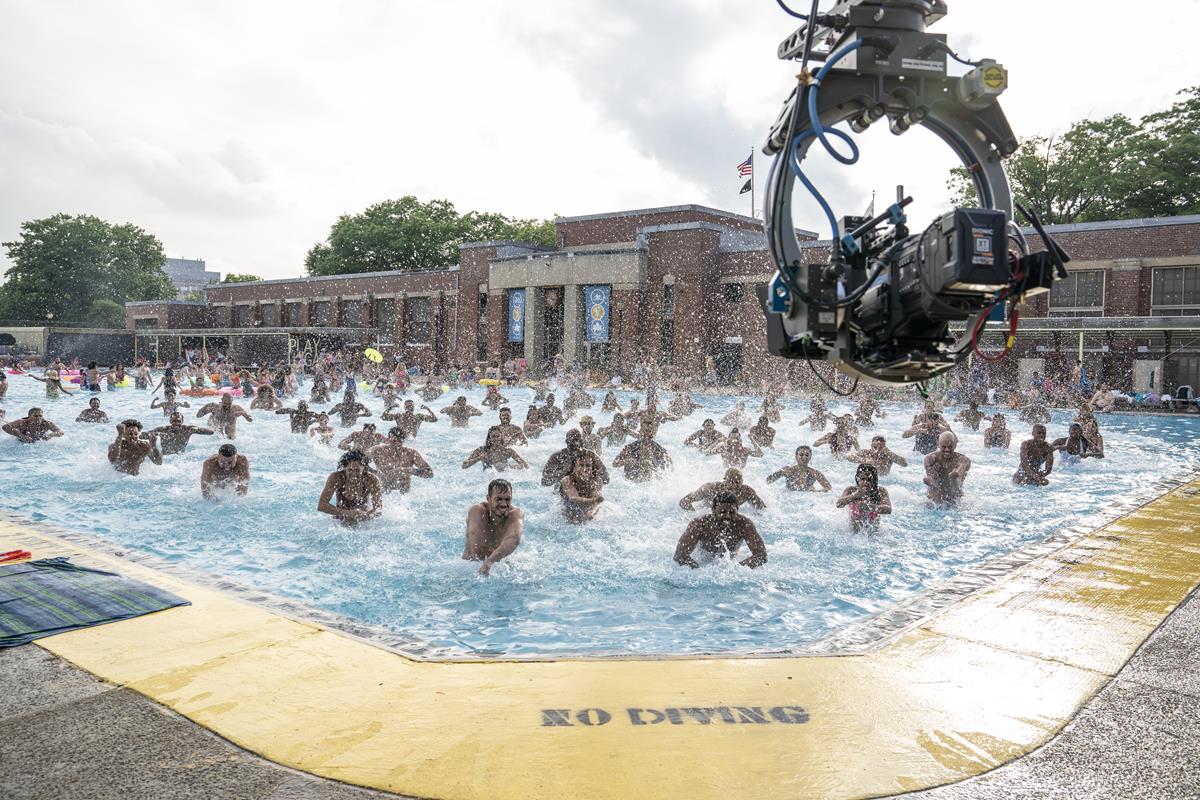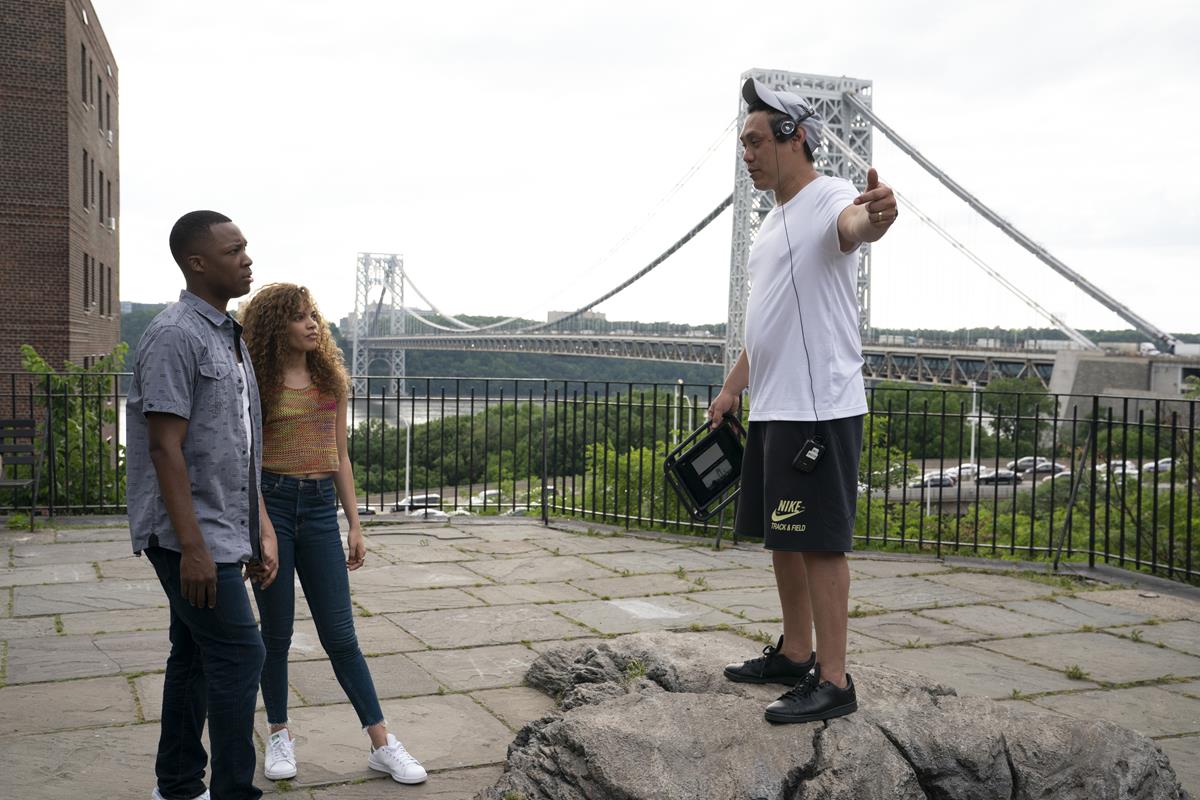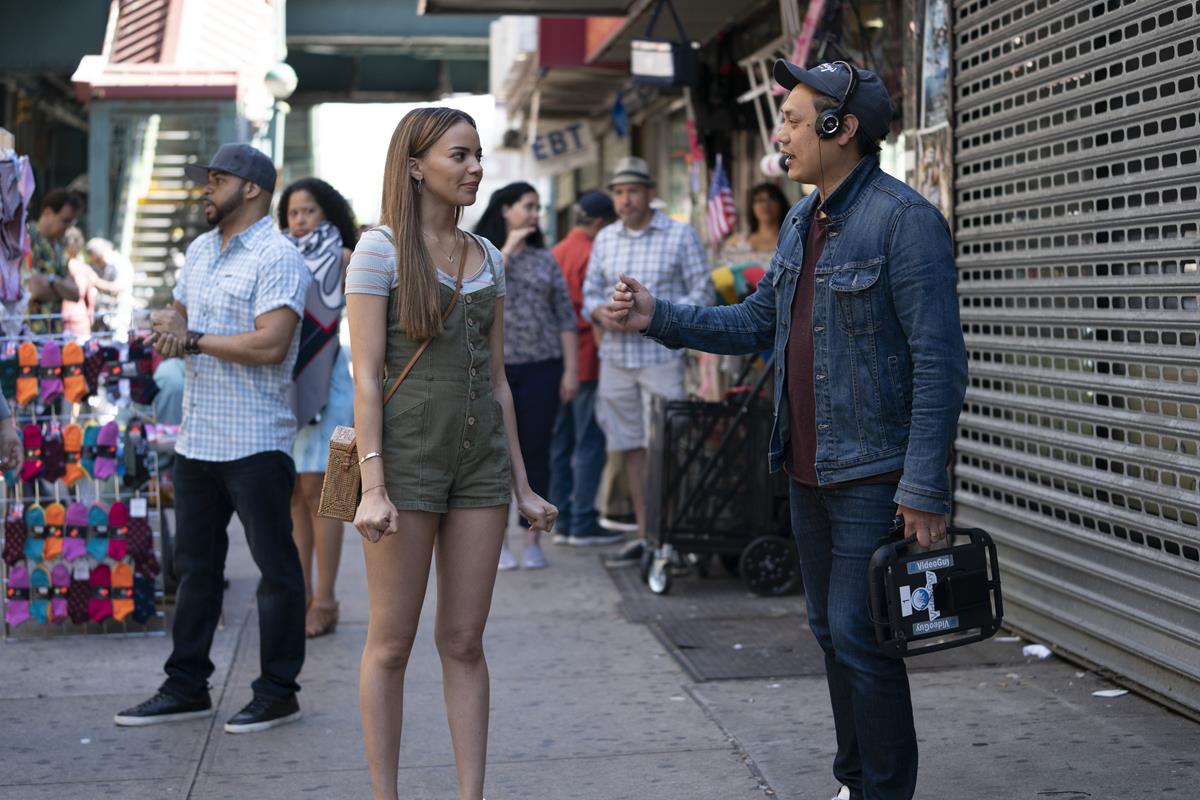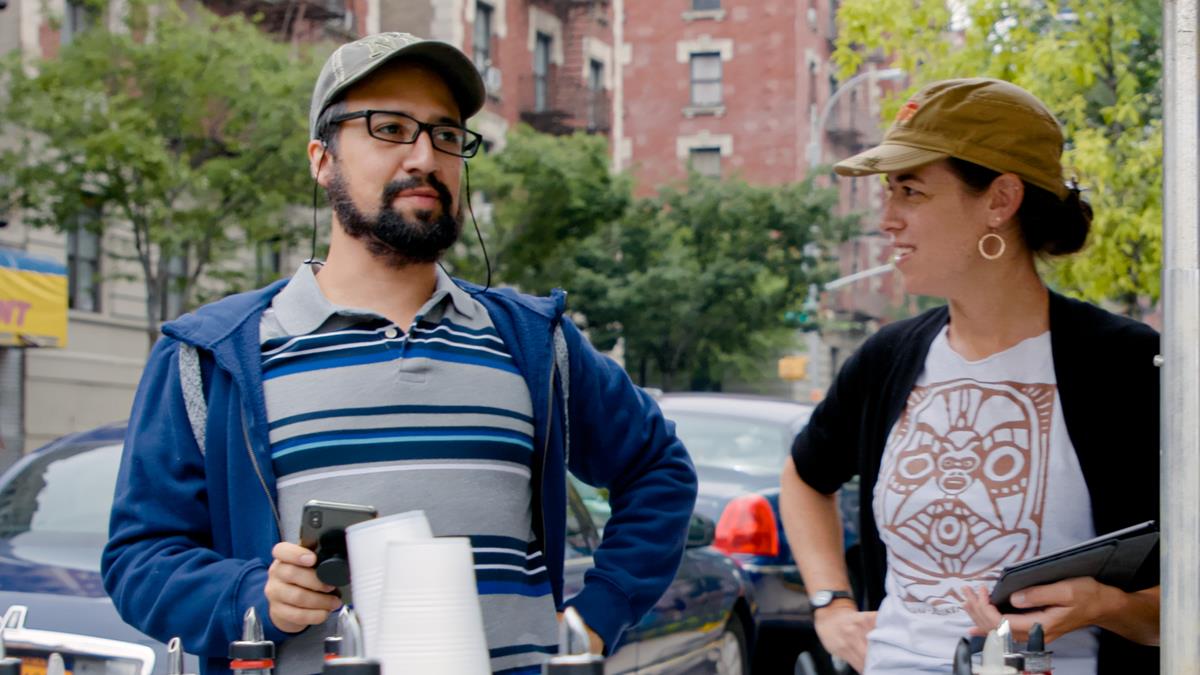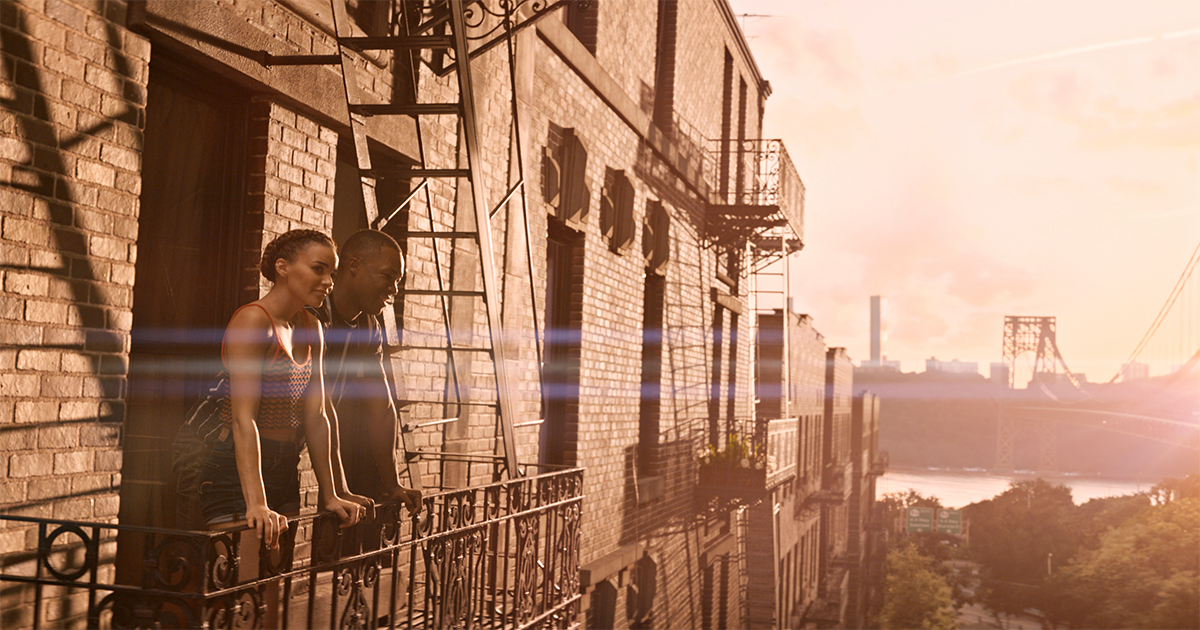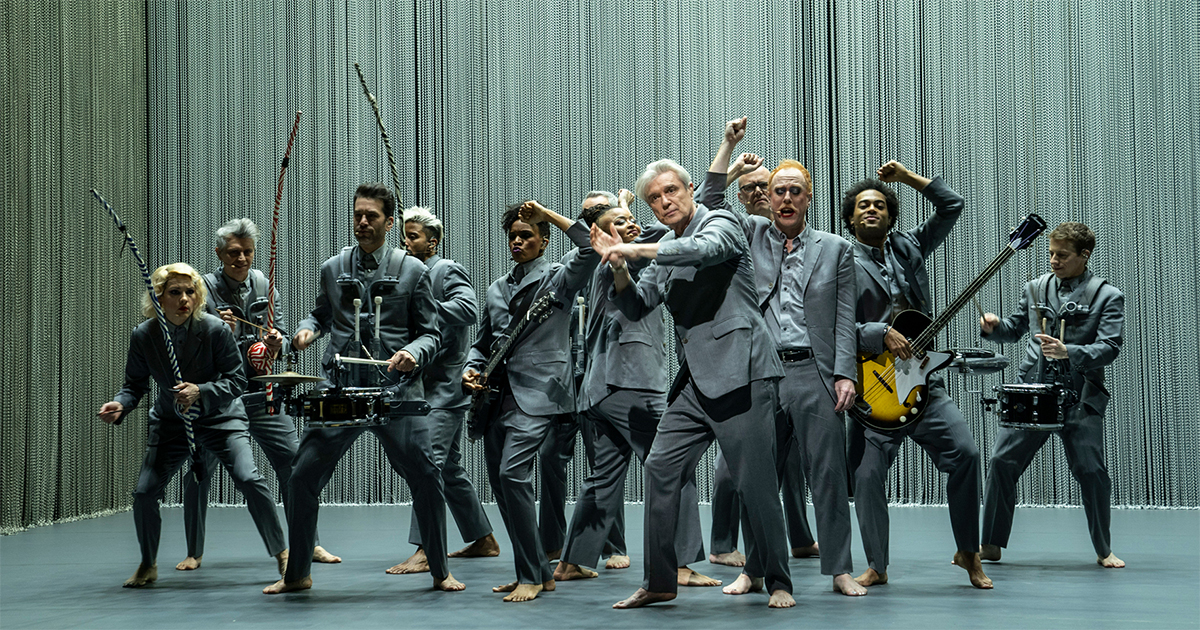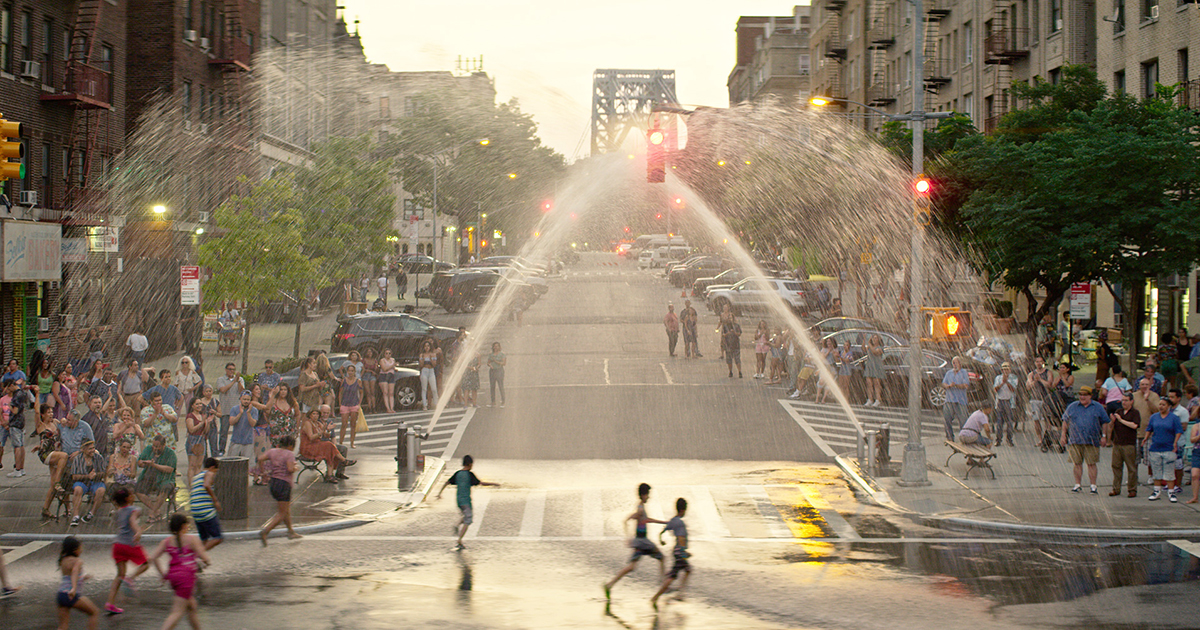
As moviegoers cautiously begin to re-enter cinemas, the film adaptation of Quiara Alegría Hudes and Lin-Manuel Miranda’s multi-Tony Award-winning stage musical, In the Heights, is now enjoying a summer theatrical launch courtesy of Warner Bros. and streaming on HBO Max.
Directed by Jon M. Chu (Crazy Rich Asians), visuals for In The Heights were captured by cinematographer Alice Brooks, who shot Chu’s thesis film — a musical short called When the Kids Are Away — while they were both studying at USC, as well as the director’s 2015 musical drama, Jem and the Holograms, and the 2010 Paramount Digital web series, The LXD: The Legion of Extraordinary Dancers.
With a screenplay written by Hudes, In the Heights stars Anthony Ramos as Usnavi, a Dominican-American immigrant whose sueñito (little dream) of leaving Washington Heights turns into something more, thanks to the magic of his New York community. The ensemble cast also includes Miranda as Piraguero, the Piragua Guy, alongside Corey Hawkins, Leslie Grace, Melissa Bareera, Olga Merediz, Daphne Rubin-Vega, Gregory Diaz IV, Stephanie Beatriz, Dascha Polanco, and Jimmy Smits.
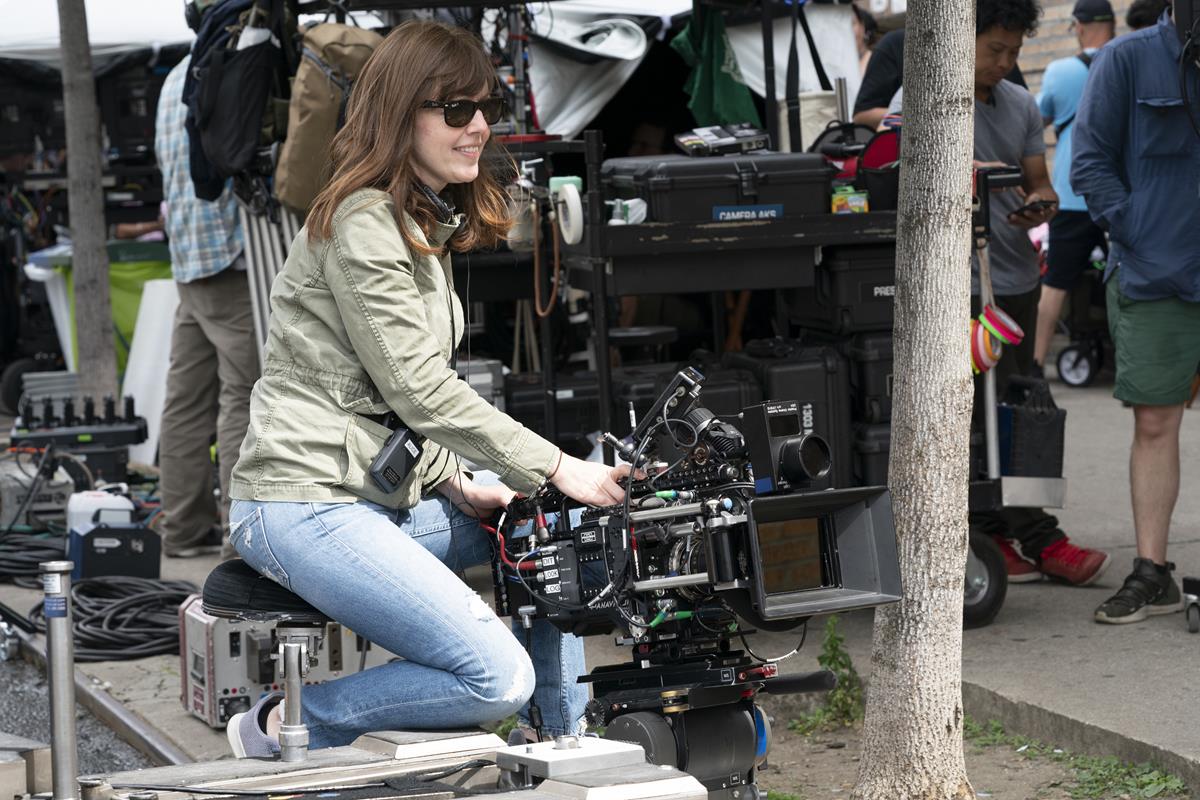
“A musical gives an audience permission to relax, imagine and not have to pay attention in such a rigid way because music does something that words alone can’t do,” Hudes tells Hanna Flint in a interview for BBC Culture:
“We’re humans, we need music. It’s one of our most basic instincts. Our hearts beat in rhythm. I don’t know what can be more essentially human than rhythm and song. Musicals have staying power because they are not just their own subgenre — they incorporate contemporary and different genres of music that’s only to the benefit of audiences.”
The film is stacked with interesting characters, Flint notes, with the ensemble cast forming a collective protagonist. “The notion of one central hero, philosophically, feels at odds with the story that I wanted to tell, which is, in a community, there is no single hero or protagonist,” says Hudes. “We rise and fall together. The community is the lead character.”
READ MORE: In the Heights and the new Golden Age of musicals (BBC)
“To capture the beauty and the depth of immigrant history in the neighborhood, Brooks chose the Panavision DXL2 with modified Panavision G series anamorphic lenses — the large-format system provided the shallow depth of field Brooks wanted for a feeling of intimacy,” Valentina Valentini writes in ICG Magazine.
The logistics for filming In The Heights were “daunting,” Chu admitted to Valentini. For four weeks, several blocks on either side of an intersection had to be blocked off in order to capture footage of the main bodega’s exterior. Shooting also had to be scheduled to work around residents’ lives.
“But Lin and Quiara were adamant about bringing it back to the place the songs were written about. And Alice and I love a challenge,” Chu said. “We hadn’t done big movies together yet, but we knew how to look, learn and use a space according to the story we needed to tell. [Choreographer] Chris [Scott] was included [in that process] because we had to build the dancing into each space, which made things even more interesting.”
There are 17 musical numbers in In The Heights, “all varied in style and staging,” Valentini writes:
“One number, ‘Paciencia y Fe,’ was filmed entirely underground in the New York City subway system and includes shots in a 900-foot-long, graffiti-covered tunnel. For ‘When the Sun Goes Down,’ characters dance on the side of a building; ‘96,000’ was shot at the Highbridge Public Pool – the first time a movie was allowed to use the location.”
Brooks worked closely with Scott, regularly attending choreography sessions just to soak in the atmosphere, she recounted to Valentini. For the seven-minute musical number “Carnaval del Barrio,” which featured 70 dancers, Brooks watched Scott rehearse for several hours without filming a thing. Once Scott was ready, he led Brooks to the center of the action so she could begin to plan the shoot.
“He held my shoulders to orient me spatially, and I used my iPhone to film the rehearsal,” Brooks recounts:
“He turned me in the direction he wanted the camera to face in each moment, and at one point whispered in my ear, ‘Go figure out where you want to be’ and left the circle. The energy of the dance number was so extraordinary — Daniela reminds her people of the power they have inside of them, encouraging them to be proud of who they are, where they came from, and where they’re going.”
Get ready to 💃!
— Movie & TV Awards (@MTVAwards) May 17, 2021
Here’s an exclusive clip from @intheheights! #InTheHeightsMovie pic.twitter.com/rvMSU5q2ek
Interior scenes of a taxi dispatch office, which were captured early in production, provided Books with the inspiration for how other interior shots should be treated, including the recreation of a bodega on a sound stage. “Brooks loved the way the reflected sun bounced off of different surfaces in the dispatch,” Valentini writes.
“A car would drive by and create a beautiful anamorphic flare for a brief moment,” Brooks said. “When that happened, I said to the gaffer, let’s make sure we have lots of reflective surfaces outside the window on the bodega set.”
Accurately portraying the color temperature of the sun and the ambient light in Washington Heights was a central concern for the filmmakers. Brooks asked chief lighting technician Charles Grubbs to pay especially close attention to the time of day and weather conditions of the neighborhood in order to attempt to re-create them at the production’s Marcy Armory stage.
“Having that control of sky color temperature and the degree of warmth and direction of sun was key to [matching stage and location work], the true motivator was the sun path in the summer season in Washington Heights,” Grubbs recalled. “It lines up with the streets at dawn and especially at sunset. The contrasting colors of the cool sky with the warm late-day sun created some beautiful lighting challenges. We made a sky source with more than 200 ARRI S60s through large grid cloth rags. The sun sources were an array of 20K Fresnel and 20K Mole beams.”
The experience of filming In The Heights fulfilled a long held goal for Brooks. “When Jon and I were at USC doing When the Kids Are Away, we were shooting in Pasadena one late afternoon, and we shut down the street for a dance number,” she told Valentini.
“It was the first time I’d ever shut down a street for filming; I was on a crane and operating, there were 30 dancers in the streets and it was thrilling. That was 19 years ago! It’s hard to believe that almost two decades later, I’d be in the middle of a shut-down street again, only instead of 30 dancers, there were 300 dancers in a massive dance number for a Warner Bros. musical. At that moment, I realized this was my sueñito — my little dream. And it had come true.”
READ MORE: My Sueñito (ICG Magazine)
In an article on the Panavision website, Brooks detailed her decision to shoot with Panavision’s Millennium DXL2 camera, which she had previously employed on the Apple TV+ series, Home Before Dark. Production designer Nelson Coates, editor Myron Kerstein and costume designer Mitchell Travers had all worked with Brooks on the series, which helped streamline things for In The Heights.
“It was great that Nelson, Mitchell and I had all done Home Before Dark together, because we very quickly understood the aesthetic of the movie,” she said. “We all knew the camera and understood how the colors were going to render.”
Following extensive camera testing, Brooks opted to pair the camera with Panavision G Series anamorphic lenses:
“This movie is a celebration of Washington Heights and of immigrants,” she reflected. “Jon said, ‘These are people with big dreams,’ and he wanted the movie to feel as big as possible. In the movie, Abuela Claudia [Olga Merediz] talks about ‘little details that tell the world we are not invisible.’ The details we picked, like anamorphic and shooting widescreen, were about saying, ‘This is a big movie about people with big dreams.’”

READ MORE: Celebrating Community (Panavision)
The most complex musical number in the film is “96,000,” which gathers the entire Washington Heights neighborhood to the public pool, where they dream of what they’d do if they won the lottery.
The scene was filmed at Highbridge Pool in Washington Heights in early June 2019, just before it was scheduled to reopen to the public for the season, Brookes recounted to Daniel Eagan in an interview for Filmmaker Magazine. “It was a tricky location,” she said “We were the first movie to film there. We started on a Monday in early June. It was cold, and it rained for two days, so we ended up shooting there for four days. Once they opened for the summer, we couldn’t shoot there anymore.” Brooks continued:
“The production did a huge outreach to the neighborhood to get them involved [and] feel a part of the movie. There were, I believe, 500 extras, many of them members of the community. That day we had three cameras, including a Steadicam with a wonderful operator named Mark Schmidt. Jon loves to do long, long takes, or just reset, not cut, because he knows he will lose people’s attention. Mark sometimes held that camera for 20 minutes without complaining.”
Capturing overhead shots was particularly challenging, Brooks revealed to Eagan: “New York City has a no-drone policy — we would have loved to use one at the Highbridge pool. It was originally part of the reservoir system for the city, so you have to cope with all these tunnels underneath. The size and weight of the cranes we could put on the pool deck were limited. We actually had to switch to spherical lenses for one overhead shot to get a larger field of view.”
READ MORE: 600 Extras on a Hot Summer Day: DP Alice Brooks on In the Heights (Filmmaker Magazine)
Brooks further detailed how the production compensated for New York’s no-drone policy while filming “96,000” in an interview with Jackson McHenry for Vulture.
“They imagined an overhead shot of Vanessa surrounded by synchronized swimmers that would typically be accomplished by putting a camera on a drone, but it’s illegal to pilot drones within New York City. Next idea: Get the biggest crane possible,” McHenry writes.
“But there’s a reservoir system of tunnels under the pool deck, and the weight of the crane was going to be too heavy,” Brooks told McHenry. “So we worked with all these engineers to figure out the exact weight allowed to get the height we needed. It was a big science experiment to figure out how many people we could fit in the frame based on the height we could get.”
Filming a water-based dance sequence presented other challenges as well, choreographer Chris Scott told McHenry. “If they wanted to get a shot of a dancer (Brandon Rosario) doing a jump and twist into the pool, that also meant calculating just how fast a camera could follow him — it would need to dunk into the water with enough force to overwhelm its natural buoyancy and fully submerge,” McHenry explains. “The scene climaxes with a sweeping overhead shot of a large group of dancers splashing in the water in unison, which Scott and his team of choreographers workshopped in a separate pool.”
“The level of the water was the biggest factor — if it’s too low, it looks dumb,” said Scott. “We had about 20 versions of that choreography.”
READ MORE: Jon M. Chu on the Pool Scene From ‘In the Heights’ (Vulture)
“Paciencia y Fe,” Abuela Claudia’s moving number about her immigrant journey moving from Cuba to New York, was “endlessly gratifying” for Brooks. “The first time I saw the dance number, when Abuela is shoved in the seat of the subway car, I started shaking,” she revealed to Carlos Aguilar in an interview for IndieWire. I knew the scene was going to be incredibly powerful,” Brooks said.
Chu initially envisioned the sequence as “elegant light show,” but the idea of a subway train kept popping into the directors head. “We then started looking at subways and we looked at all these platforms that the MTA allows you to shoot on, but they all just felt very confined,” Brooks told Aguilar.
The production eventually learned of an abandoned MTA station in Brooklyn, bringing in both modern and older train cars so they could utilize both sides of the platform. “When she comes out in one platform we have one lighting set up that refers to Cuba,” Brooks said. “The color of Cuba is a warm, yellowish light. Then the color of New York is cold.”
READ MORE: How Alice Brooks Shoot on Location (IndieWire)
The neighborhood of Washington Heights stands as a character in the film, playing itself to perfection. “I think the neighborhood spoke for itself. Washington Heights wasn’t just a cast member — it was a crew member, it was a co-writer, it was all those things,” Chu tells Alissa Wilkinson in an interview for Vox. “Even right now, it’s our biggest fan. The people who come from there, the way they are pumping up our movie — you can feel their spirit,” he says.
“The biggest compliment we get is this movie feels so New York,” Chu adds. The reason it feels New York is because of that community. That’s New York. That’s not the Empire State Building New York. That’s Washington Heights.”
Spike Lee’s seminal Do the Right Thing “is an inspiration to all movies in New York,” as well as to him, personally, Chu remarks, “But the reality was, I didn’t know what it was going to be like until I got to Washington Heights, and I was shown this neighborhood by Lin and Quiara. They were the best tour guides you could ask for. Lin would say, ‘This is where I shot my home videos, in this tunnel at 191st Street — this is the spot.’”
READ MORE: In the Heights movie interview: Lin-Manuel Miranda and others on adapting the hit musical (Vox)
Brooks had wanted to shoot an In The Heights adaptation for years, long before Chu had been signed to direct the film, she revealed in an interview with Danielle Solzman for Below The Line:
“I had wanted to shoot this movie for years before being signed on to the film, but I had never seen the stage show on Broadway at all. I was very aware of the project and when Jon Chu became attached to it — Jon and I went to USC film school together and we did a short musical in college called When The Kids Are Away. We bonded over our love of musicals. When I knew Jon was going to do a musical and that it was going to be in New York, where I grew up, I knew immediately I wanted to be a part of that.”
The cinematographer also made a conscious effort not to watch any musicals while they were prepping the film. “Or anything current or modern,” she says. “I think the most recent film I watched was probably made in the late ‘80s or probably early ‘90s. What I did look at were classic New York movies and that was an inspiration to me. I also took a lot of my own stills while scouting and the biggest influence visually for the movie was the community itself.”
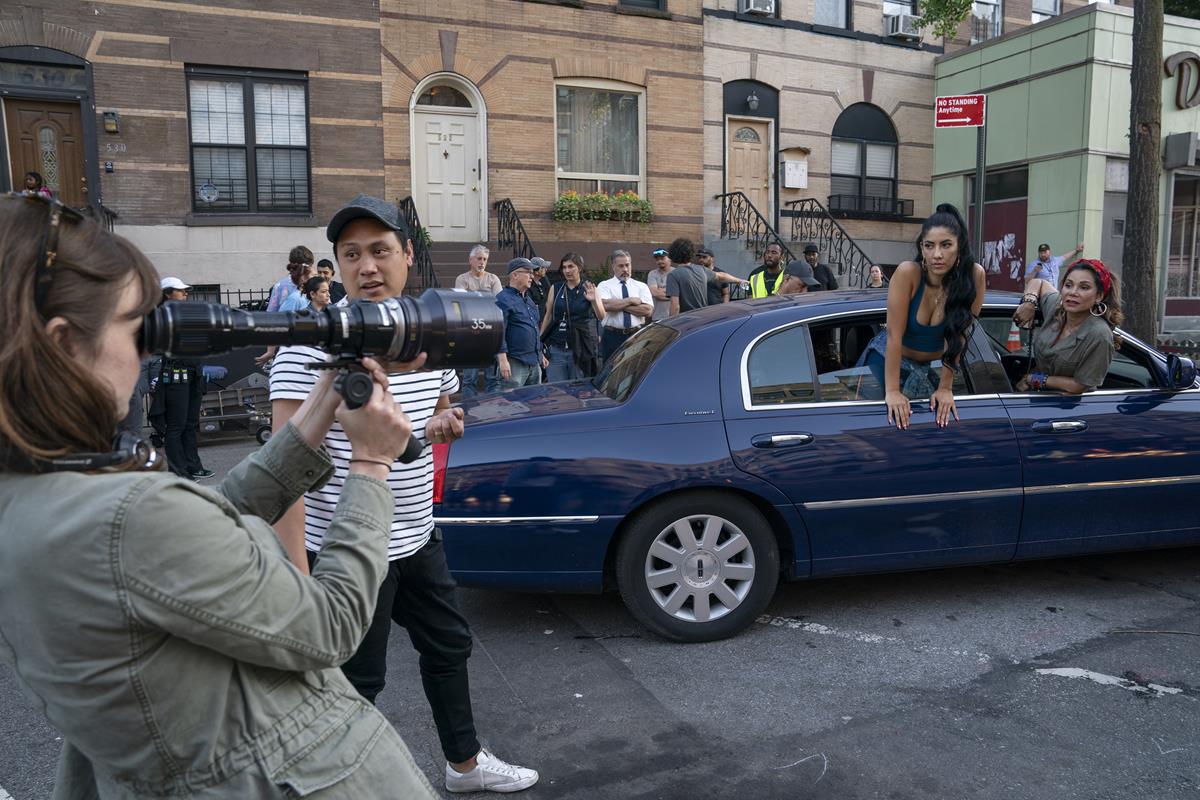
Her next project, Brooks tells Solzman, is Miranda’s upcoming directorial debut, tick, tick…BOOM! Arriving this fall, production for the Netflix feature was interrupted by the COVID pandemic, but Brooks is looking forward to finally returning to work.
“All the studios have done an excellent job getting people back to work, and it’s very impressive how well taken care of and safe an environment productions have become,” she said:
“I hear it across the board — people feel really, really well taken care of and that is wonderful. I’m looking forward to shooting now that I’m fully vaccinated. I’m looking forward to shooting something in about six weeks. I know we’ll still have all the same protocols with mask wearing, social distancing, and being tested. I think, overall, the studio wanted everyone to feel safe so that they could do their job really well and I think they’re achieving that.”
READ MORE: In the Heights Cinematographer Alice Brooks Fulfills Her Dream to Film the Musical (Below The Line)
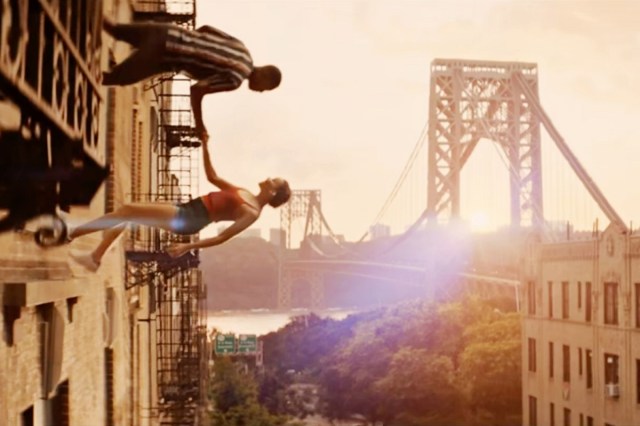
For the Fred Astaire and Ginger Rogers-inspired musical number, “When the Sun Goes Down,” two young lovers drenched in the golden light of “magic hour” — Nina (Leslie Grace) and Benny (Corey Hawkins) — dance up the side of a Washington Heights apartment building. director Jon M. Chu, cinematographer Alice Brooks, and choreographer Christopher Scott discussed how the sequence was achieved on a recent episode of IndieWire’s “Filmmaker Toolkit” podcast hosted by Chris O’Falt.
An homage to the iconic “anti-gravity” dance number performed by Astaire in Royal Wedding, the sequence is a perfect blend of cinematography and visual effects.
To help ground the VFX, the filmmakers opted to begin the sequence with a lengthy minute-and-a-half shot that relied on practical effects. The production team reconstructed the exterior of the building with a moveable wall that could be folded to the floor. Special effects coordinator Jeff Brink created a hydraulics-powered platform that could support the weight of the dancers and set as it went from vertical to horizontal.
“What happens is we start with a vertical wall, with Benny and Nina standing on the fire escape, and as the fire escape starts to slowly tilt, the camera is slowly moving, and suddenly we’ve completely hidden the fact that wall has tipped completely flat,” Brooks recounted.
Deciding on which camera moves to employ for the number proved to be a challenge, the DP admitted:
“Initially we thought, “OK, we’ll attach the camera to the wall and that would be the easiest way to do it,” but when we did this previsualization we realized that wasn’t the best way to do it. They created this whole setup in a VR world where we wore googles, and we had the camera and we had two dancers working with us, so we spent a Saturday doing this, where it was our test shoot basically.
“We wanted to know where the horizon should be vertical and where it should be horizontal, what would be the most effective, and what kind of moves, between the camera and the dancers would actual sell this anti-gravity feeling and also the feeling like would Nina fall at some point. So when she reaches down to touch the water dripping we dip with her.
“What we discovered here was that the best way to sell this shift was to have as long a first shot as possible. Once the wall is down, the shot is dead, but we had another 30 seconds of them dancing in the oner, so we shot it on a technocrane, so we’re telescoping at the same time we’re booming.”
The sequence was shot against green screen on a sound stage, and later composited with VFX plates of the real Washington Heights block with the George Washington Bridge in the backdrop. Matching the quality of the light and the precise angle of the sun on the sound stage was also challenging for Brooks:
“The lighting source for the sky source was very easy to keep in sync because they were LEDs attached to our dimmer board, so they were locked into the soundtrack, into the music, so the moment in the music where the wall started going, those lights started going.
“But the light source for the sun, a 20k Fresnel on the crane, had to be timed exactly perfectly, and not only that, the wall is on a hydraulics, so that it not always perfect.”
The sequence was “probably the most expensive piece that we had in our movie, but also the most risky.,” Chu said. “It pressed to work hard, to be more creative, to really question why. Why are we spending all this money on a turning building? Because we want to show that Fred and Ginger could have been Corey and Leslie back then if they were allowed to, it could have been, but we didn’t allow that.”
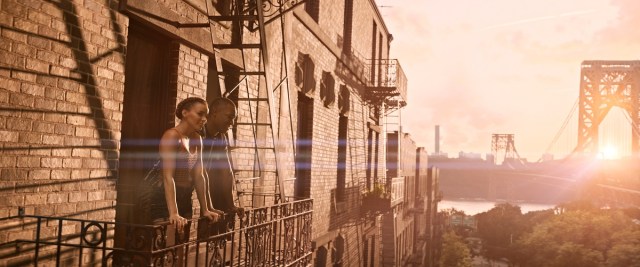
READ MORE: ‘In the Heights’: How They Danced Up the Side of a Building (IndieWire)
Want more? Watch the Go Creative Show podcast episode, “In The Heights Cinematography with Alice Brooks,” in the player below. During the episode, the DP shares her cinematic approach adapting Lin-Manuel Miranda’s hit Broadway show to the big screen, including the challenges of filming musical numbers on location, visuals inspired by local photographers, and the Panavision DXL2 camera and NYC lighting. There are also breakdowns for “96,000,” “When the Sun Goes Down,” “Champagne,” and “Paciencia y Fe,” as well as advice for young and female DPs:
Listen to this episode of the Pro Video Coalition’s “Crossing the 180” with In The Heights director of photography Alice Brooks, which delves into the complexity in shooting musicals and choreographed dancing, how they performed some of those more complex scenes from the movie (like the dancing on the side of the building scene), and some of the technical challenges they faced and how they were overcome:
You can also watch “Anatomy of a Scene,” from The New York Times. In the video, In The Heights director Jon M. Chu details the shoot for the opening sequence for the film, including staging Anthony Ramos’ performance, and how the production used a real bodega for exteriors but recreated a bodega on a set for the interiors:


